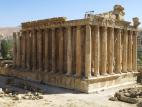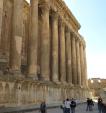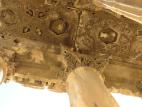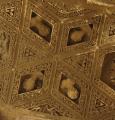








Known in antiquity as 'Heliopolis', Baalbek was the site of one of the largest temple complexes in the ancient world. A temple to Jupiter was completed in about 60AD and a further three temples, to Venus, Bacchus, and Mercury, over the following century or so.
| Part of the remains of the propylaea (entrance gate to the complex) | 
| |
| Apart from foundations, all that remains of the Temple of Jupiter is six pillars. Part of the destruction was deliberate (the emperor Justinian had parts of the temple destroyed, and further damage was done in the Arab conquest in 748 and by Tamerlane in 1400), but most of it was the result of large earthquakes. The biggest one, in 1759, killed thousands of people in the region. It left only nine pillars standing, and three collapsed in the earthquake of 1870, leaving just these six. |  |
 |
| The most nearly intact temple at Baalbek, and one of the best-preserved Roman temples anywhere, is the Temple of Bacchus. On a lower level than the Temple of Jupiter, it had been protected by being partly buried during the strongest earthquakes, and was excavated around 1900. Some damage was done by Israeli attacks on Baalbek in 2006. |  |
 |
| Some of the fine decoration has survived. |  |
 |
| Detail of the fine stone carving under the roof. |  |
 |